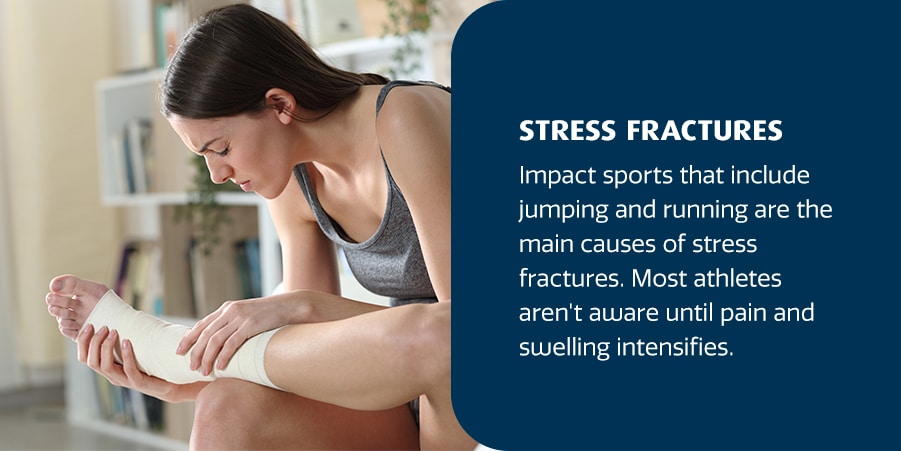Many student athletes actively participate in sports throughout the school year without a break in between seasons. They often push through their heel pain, ankle injury or other aches and pains until the next sports season begins. It is common for these issues to be placed on the back burner behind practice, homework and family time. Neglecting issues can be extremely dangerous.
Small issues can become major problems, hampering their ability to participate in sports and even school work if they result in an injury requiring lengthy recovery time.
Foot Injury Complications
Basic health frequently gets neglected — a minor injury or nagging ailment can get filed away under “we can take care of it later.” Powering through pain is a common theme among driven student athletes.
Unfortunately, it’s also very dangerous. Injuries and chronic conditions can strike anyone, especially the most active. At Foot & Ankle Surgical Associates, we take special care of student athletes and empower them to take care of themselves so they remain active and competitive.
Whether your child engages in football, baseball, cheerleading, wrestling, bowling or any other sports, injuries can happen, and the pressure and repetition of most of these activities can lead to chronic conditions. You want a podiatrist who understands athletes and is dedicated to getting them back on the field and in top shape. If left unattended, student athlete ankle injuries can lead to numerous complications, including extreme pain and loss of mobility, ultimately ending their athletic career prematurely.
Common Student Athlete Foot Injuries
As a concerned parent, it’s important to note any signs that may indicate injuries that can lead to bigger problems later on. Here are a few common student athlete foot injuries your child may experience.
Foot and Ankle Fractures, Breaks or Sprains
Some of the most common foot injuries include fractures, breaks and sprains. You can generally distinguish them by pain intensity, though there are other physical signs to look for:
- Fracture: The ankle has three main bones — the fibula, tibia and talus. Fracturing any of these bones leads to minimal or severe pain, depending on whether it’s a hairline or a bigger fracture.
- Sprain: You’ll notice a sprained ankle when the ligaments are torn or damaged, making it difficult to walk. The ankle ligaments are tiny elastic-like straps of tissue and muscles bound tightly, providing joint stability. Spraining or tearing a ligament can be extremely painful, and while a sprain heals up on its own, a torn ligament may require surgery if the pain is too severe.
- Break: Depending on the break’s severity and whether the bone pierces through the skin, you’ll quickly identify a broken foot or ankle. The foot may swell and turn blue, and you won’t be able to place pressure or stand on it at all. Hospitalization or a doctor’s urgent care is needed.
Ingrown Nails
The pain from ingrown toenails is often so intense that it can affect your child’s daily life and activities, especially if they’re active in sports. It is usually caused by cutting the nail round along the edges, instead of straight across or wearing shoes that are too tight around the toes. The skin around the toe is sensitive to touch and often red and swollen if the ingrown nail is deeply embedded. It’s most common in the big toe.
Ingrown toenails may require the nail to be cut out if the infection causes indescribable pain. A doctor may prescribe antibiotics and painkillers if it’s not that bad yet, as well as suggest an effective foot care routine and show you how to trim your toenails correctly.
Nail Fungus
Nail fungus is identified as brown or yellowish spots beneath the nail tip caused by infection. It can spread across the entire nail, causing it to thicken and discolor. In extreme cases, the nail bed can crumble and potentially fall off. It’s not always associated with pain but can cause discomfort. It can lead to smelly feet that can be embarrassing for some children.
Treatment includes using antifungal creams and powder, keeping the nails clean and dry, wearing the right socks and shoes and letting the feet ‘breathe’ as much as possible.
Athlete’s Foot
Athlete’s foot is also a foot fungus that affects the skin beneath the foot and between the toes. It is distinguished by itching that can cause pain and irritation when scratched too much. The skin is usually dry and peels easily. It is highly contagious and often spreads in school gym showers when students don’t wear flip-flops to protect their feet. Wet or sweaty feet are also more prone to developing athlete’s foot.
There are over-the-counter treatments for the fungus. If the condition worsens, consult with a specialist for further steps.
Stress Fractures

Athletes may cause injuries they’re unaware of through repetitive strain or stress on a weakened bone, leading to tiny fractures that may worsen over time. Impact sports that include jumping and running are the main causes of stress fractures. Most athletes aren’t aware until pain and swelling intensifies.
If there’s no visible evidence of foot injury, but your child complains about pain, it could be a stress fracture. Consult a podiatrist for the best route to ease the pain.
Plantar Fasciitis
If your child has heel pain, it could be inflammation in the foot tissue called the plantar fascia located beneath the foot, close to the heel. The most common cause of plantar fasciitis is wearing improper shoes, which can be aggravated by exertion while playing sports.
Treatment is generally nonsurgical, but getting the right advice is important to ensure effective treatment and recovery.
Shin Splints
Pain in the shin or tibia — the long bone in front, beneath your knee — is known as shin splints and is identified by pain, tenderness and swelling along the shin bone. It’s caused by excessive use and triggered in athletes who undergo intense training.
You can treat it with ice packs when the pain flares up, while rest and pain medication also help ease the pain. A doctor or podiatrist should treat prolonged or severe pain, especially if it persists for more than two weeks or after training intensity decreases.
Book an Appointment With a Podiatrist at Foot & Ankle Surgical Associates
Postponing your child’s treatment can result in greater harm down the line, while being properly diagnosed and expertly treated can set them up for a lifetime of exercise, competition and fun.
If your child has suffered a foot injury or has been neglecting an ache or pain, the dedicated staff at Foot & Ankle Surgical Associates will gladly assist in diagnosing the issue and offer advice on the way forward. We have all the tools to keep your child in the game and enjoying the things that they love.
When you’re ready, book an appointment today. 





